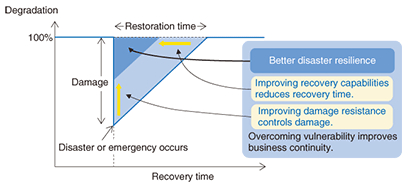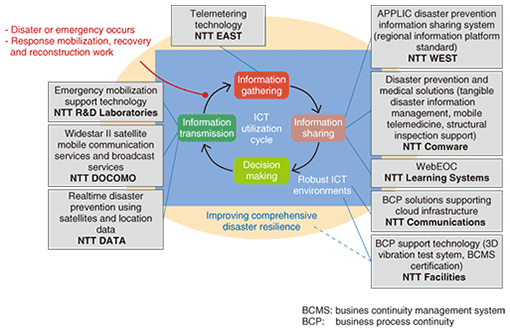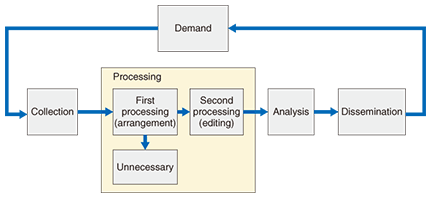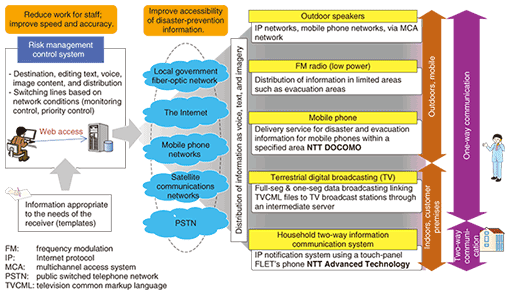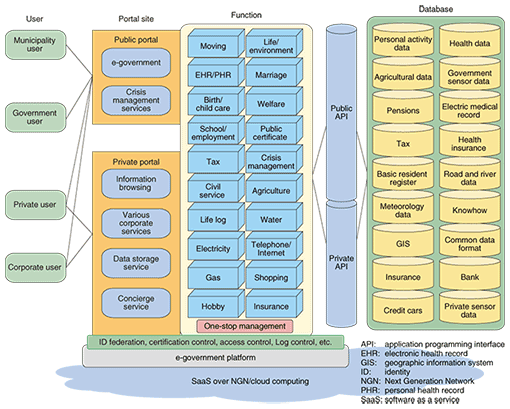 |
|||||||||||||||||||
|
|
|||||||||||||||||||
|
Special Feature: Disaster Prevention and Management Solutions for Better Comprehensive Disaster Resilience Vol. 8, No. 12, pp. 10–16, Dec. 2010. https://doi.org/10.53829/ntr201012sf1 ICT Utilization and R&D Initiatives Contributing to Better Comprehensive Disaster ResilienceAbstractIn this article, we introduce the current status of information and communications technology (ICT) usage and NTT research and development (R&D) initiatives toward better comprehensive disaster-resilience capabilities, which are very important for society. Disaster resilience covers disaster prevention measures for preventing avoidable incidents and disaster response and management measures for reducing or preventing damage when a disaster or emergency occurs and recovery capabilities for reducing the time required for restoration.
1. IntroductionSome disasters can be prevented through design and procedures, but others cannot be prevented but only mitigated. Minimizing the damage to society, organizations, communities, households, and individuals when a disaster or emergency occurs and overcoming vulnerabilities to crises are very important issues. The range of threats to our life in society has been increasing recently. Besides disasters with a long history such as damage caused by natural phenomenon like storms, typhoons, earthquakes, and tsunami and man-made disasters such as building fires and collapses, there are also newer threats such as swine flu and terrorism. The ways of overcoming vulnerability to these sorts of disasters and emergencies are explained below [1]. The graph in Fig. 1 shows the degree of degradation in societal function on the vertical axis (greater damage indicated by a larger drop) and time on the horizontal axis. Thus, vulnerability to disaster is indicated by the area of the blue triangle. To overcome vulnerability, one should minimize this area, which involves improvements to comprehensive disaster resilience. It is important to implement measures that address both aspects of vulnerability; namely, the magnitude of damage (vertical axis), and the recovery time (horizontal axis). Thus, better comprehensive disaster resilience involves two perspectives.
(1) Reducing recovery time by improving recovery capabilities: This includes (i) preparing response manuals and conducting drills so that when a disaster occurs, responses can be carried out quickly, efficiently, and without confusion and (ii) establishing and executing rapid evacuation and response plans based on realtime information gathering and sharing. (2) Controlling damage by improving damage resistance: By building redundancy into networks and systems, one ensures that if one system is damaged, services can switch to another system without interruption. Information plays a very important part in measures for both perspectives. In addition to sharing this information in real time, one must utilize information and communications technology (ICT) to process the information according to the purpose and present it in a suitable (easy to understand) form to people for disaster prevention and management. 2. NTT Group solutions utilizing ICTFor better comprehensive disaster resilience when disasters or emergencies occur, it is very important to use technical products and solutions that follow the ICT utilization cycle shown in Fig. 2, which shows some technologies and products from NTT Group companies. ICT is used to help control damage and reduce recovery time. For example, damage due to down time in ICT systems that are essential to business operations or daily life can be prevented by adding redundancy and distributing facilities geographically (using robust ICT environments). ICT can also be used during serious disasters to immediately gather information about the degree and location of damage using sensors (information gathering) and share information with appropriate team members via systems that express this information using electronic maps and other means (information sharing). Decisions can then be made, such as where to dispatch people to assess the damage in detail and where evacuation may be required (decision making), and data transmission systems can send information to response teams, company employees, and local residents as required (information transmission). Rapid and efficient execution of this cycle can be effective in reducing the recovery time.
Even if rapid and appropriate information gathering and sharing and decision making will not contribute to better comprehensive disaster resilience unless integrated with real action, such as evacuations or safety notifications to affected people. So, while information transmission is certainly important in supporting the actions of those involved, how this information is released (content and timing) is also an important element. We are keeping this in mind as we introduce the various research and development (R&D) initiatives described below. 3. NTT R&D initiativesNTT is promoting R&D with the goal of implementing emergency response systems capable of handling all kinds of emergencies such as natural and man-made disasters, large-scale accidents, and contagious outbreaks. In this article, we introduce some research that focuses on information, an important element in responding to emergencies. 3.1 Value of informationThe Great Hanshin/Kobe Earthquake in 1995 was instrumental in raising awareness of the importance of information in responding to emergencies. When the disaster struck, an unprecedented and unimaginable amount of damage occurred. Furthermore, even though the people in the disaster area were aware of the conditions surrounding them, they had no way of comprehending the overall situation, and it was quite some time before they could gain such an understanding. One result of this new awareness was recognition, for the first time, that speed and effectiveness directly after a disaster occurs and up to the initial mobilization is an important determining factor in the quality of subsequent emergency response activities [1]. From this background emerged the need for disaster response systems to shorten the information vacuum period directly after an emergency occurs, and most of these have focused on information gathering and summarizing functions, such as observation equipment, elevated cameras, and other video equipment. However, 15 years have now passed since the Great Hanshin/Kobe earthquake, and there is new awareness of the problem that simply gathering information is not sufficient to prepare the systems, execute the emergency response, and make the required decisions quickly and accurately [2]. Beyond simply gathering information, other important factors are the quality of the information, depending on what is needed for the next response activities, and the information requirements (what sort of information is needed and by when, etc.) [3]. A model of the flow of information processing during a response to an emergency (intelligence cycle) is shown in Fig. 3. Below, we introduce some specific research focusing on the importance of information requirements.
3.2 Bulletins encouraging evacuation of residentsWhen there is a possibility of danger to residents such as flooding or landslides due to heavy rain, local governments must issue warnings and give instructions to evacuate. However, examples from recent years indicate that most residents in affected areas did not begin evacuating even when evacuation recommendations were issued. For example, in Toyooka City, which suffered severe damage from Typhoon 23 in 2004, approximately 43,000 residents were advised to evacuate, but only about 3700 (ca. 8.6%) actually did [4]. This shows how only having information and transmitting it to people during a disaster does not directly lead to reductions in the disaster’s effects. Furthermore, most of the casualties from typhoon- and storm-related disasters occurring in Japan in recent years have been elderly persons. This has led to recognition that measures providing help to those with difficulty evacuating quickly on their own in times of disaster is important. Because of this, Japan established “Evacuation Support Guidelines for Those Requiring Support in Time of Disaster” [5] in March 2005 and published a companion to them, “Procedures for Dealing with Those Requiring Support in Time of Disaster,” in March 2007 [6]. However, even in these guidelines, there is almost no mention of policies or recommendations for data content related to the actions taken. Thus, we began to focus on what sort of information would encourage residents to evacuate when necessary and to study what information should be provided to citizens by local governments (information requirements for residents) and what form this information should take. Currently, governments issue this information on the understanding that there is a life-threatening level of danger, but residents receive it with the attitude that the danger level is not particularly high, so there is a difference in understanding and awareness of the danger level between the two parties. With an awareness of this problem, we conducted surveys regarding the actual wording of evacuation warnings issued and distributed on the basis of official evacuation recommendations using participants in local disaster-prevention and response exercises. As a result, we discovered that the information required by residents depends on the characteristics of the disaster itself (e.g., how long before it strikes) and the characteristics of those receiving the information, especially in the case of those requiring assistance for evacuation. Finally, we must consider the sort of information that will spur residents to begin evacuating that can be conveyed to them in at the time of a disaster. Specifically, the study results show that information distribution templates could be prepared in advance, which would reduce the load on local government staff if they were used to distribute information after an emergency occurred. Furthermore, the risk management control system shown in Fig. 4 could instantly distribute to residents information suited to their needs, which would lead to more effective emergency responses.
3.3 Towards a more disaster-resilient societyHere, we introduce future R&D initiatives. In FY2009, we established the Kyoto University/NTT Resilience Joint Research Group based on a contract to promote cooperation on an organizational (comprehensive) level. One result of this has been the publication of a document entitled “Creating a Disaster Resilient Society” [8]. This document represents the combined efforts of the Disaster Prevention Research Institute of Kyoto University and NTT Laboratories to begin to define a public vision for emergency management, summarizing the essence of resilience (ability to withstand disaster) and contributing to the creation of a sustainable society with continuity of enterprise and management of disasters and emergencies. The document was written for those in charge of disaster prevention and response in small, medium-sized, and large businesses as well as in local public organizations, administrations, and government. It provides information about the importance of disaster prevention, about new ideas and ways of thinking, and about new technology and services related to disaster prevention. It also expresses a vision for creating a new disaster-resilient society. The disaster-resilient society that we are considering here (Fig. 5) is achieved by building a social framework that is autonomous, cooperative, and distributed (self-, mutual-, and public help) using next-generation communications services such as cloud computing. Specifically, disaster and emergency response systems have to date been built independently by governments at the state, city, town, and village levels. As a result, not only have governments paid high costs to build and maintain these systems, but when disasters or emergencies do occur, each level of government pursues its own individual countermeasures and no progress toward cooperation is made. This also makes it difficult to accumulate know-how within governments and does not allow for an adequate level of training for disaster and emergency management staff. To resolve these types of problems, it will be important to standardize disaster prevention tasks and build mechanisms using a cloud infrastructure rather than having separate systems for each level of government. In the framework portrayed in Fig. 5, a unified portal provides various next-generation e-government public services as well as private services, in addition to disaster prevention, and other government know-how can be shared nationally as needed.
To achieve a disaster-resilient society, we must make emergency-management functions into extensions of the tasks for every-day activities and not things needed only during emergencies. They must become extensions of every-day services. Ultimately, once the various services together are linked together, new services will be built that were impossible before, which will reduce the workload and cost for government bodies. At NTT Service Integration Laboratories, we are studying a framework of this sort and conducting R&D on relevant new technologies and services. References
|
|||||||||||||||||||








